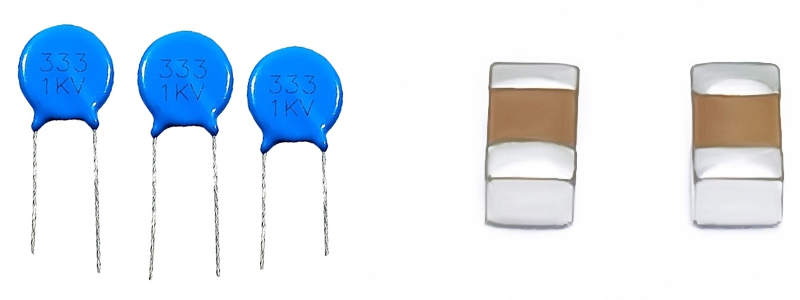What is a Ceramic Capacitor?
Ceramic capacitors use ceramic materials with high dielectric constant and low loss as the medium. The silver layer is sprayed on both sides of the ceramic substrate, and then the silver film is fired at high temperature as electrodes to weld the leads. The outer surface is coated with protective enamel or encapsulated with epoxy resin. The capacity is determined by the area and thickness of the ceramic sheet, and the pressure resistance is determined by the thickness of the ceramic. Its shape is mostly disc, and there are also tubular, circular and other shapes. Usually blue is the most common, followed by yellow, brown and so on. Universal ceramic capacitor is characterized by small size, good heat resistance, low loss, high insulation resistance and small capacity, and is suitable for high-frequency circuits.

Types of ceramic capacitors
- Distinguish by withstand voltage: high voltage ceramic capacitors (above 1KVDC), low voltage ceramic capacitors (below 500VDC).
- Distinguish by frequency: high frequency ceramic capacitors, low frequency ceramic capacitors
- Distinguish by the structure: Disc ceramic capacitors, SMD multilayer ceramic chip capacitors
Difference between high frequency capacitor and low frequency capacitor
High frequency ceramic capacitor (Class Ⅰ ceramic capacitor) refers to a capacitor made of ceramic dielectric with low dielectric loss, high insulation resistance, and dielectric constant that changes linearly with temperature. It is particularly suitable for resonant circuits, and other circuits that require low losses and stable capacitance, or for temperature compensation.
Low frequency ceramic capacitor (Class Ⅱ ceramic capacitor) refers to a capacitor using ferroelectric ceramics as dielectrics, so they are also called ferroelectric ceramic capacitors. The specific capacitance of this type of capacitor is large, the capacitance changes nonlinearly with temperature, and the loss is large. It is often used in electronic equipment for bypass, coupling or other circuits that do not require high loss and capacitance stability.

